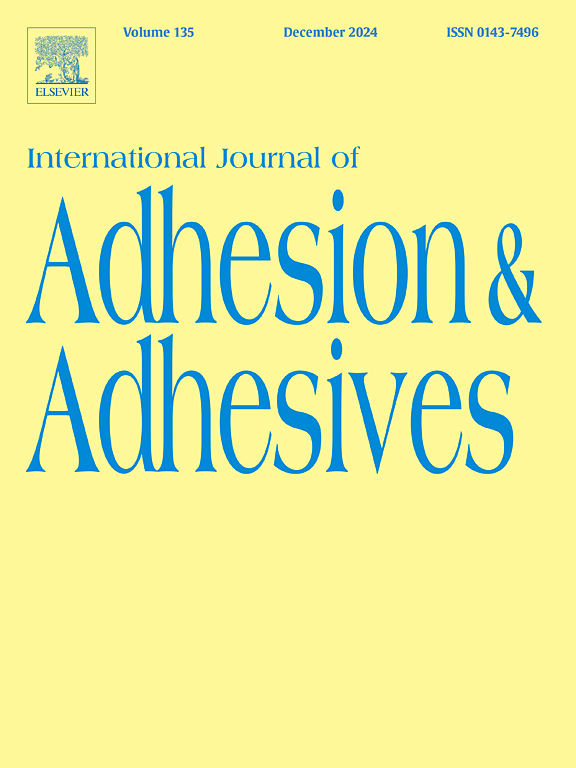Thermally stimulated bio-acrylate based detachable adhesives with sustainable bonding-debonding design
IF 3.2
3区 材料科学
Q2 ENGINEERING, CHEMICAL
International Journal of Adhesion and Adhesives
Pub Date : 2024-10-12
DOI:10.1016/j.ijadhadh.2024.103853
引用次数: 0
Abstract
The electronics and automotive industries utilize acrylic adhesives extensively. Their exceptional mechanical strength, accompanied by their permanent nature, renders recycling impracticable. Present work has successfully synthesized acrylate biopolymer based detachable adhesive, which is both eco-friendly and sustainable. Glycerol, from mustard oil, was oxidatively-dehydrated to synthesize acrylic acid, which along with dimethyl glyoxime was chain polymerized to obtain an eco-friendly acrylic based hot melt detachable adhesive (AAHMDA). Mechanical strength of prepared adhesive was tested through thermo-mechanical bonding-debonding cycles on glass, wood, and metal. In three tests of 0.2 g adhesive against specific applied stress on all surfaces, metal (1494.49 N/m2) and wood (1851.17 N/m2) remained intact for 2 h and 30 min. Maximum cleavage stress (applied weight) on glass, wood, and metal slides, using 0.2 g adhesive, was found to be 26503.61 N/m2 (1200 g), 19824.71 N/m2 (950 g), and 26328.24 N/m2 (1300 g), respectively, when repeatedly tested for 15 cycles. Gel contents and water absorption capacity of sample were found at 99.79 % and 38.78 %, respectively. Prepared AAHMDA possesses the capability to create a robust mechanical bond that is readily detachable when heated, which makes it a cost effective adhesive. Owing to its strong bonding and simple detachment procedure, AAHMDA appears to have a promising future in materials research, sustainability initiatives, and changing industry demands.
基于热刺激生物丙烯酸酯的可分离粘合剂,采用可持续粘合-拆分设计
电子和汽车行业广泛使用丙烯酸粘合剂。丙烯酸粘合剂具有超强的机械强度和永久性,因此无法回收利用。目前的研究成功合成了基于丙烯酸酯生物聚合物的可拆卸粘合剂,这种粘合剂既环保又可持续。从芥子油中提取的甘油经氧化脱水后合成丙烯酸,丙烯酸与二甲基乙二醛肟经链式聚合后得到一种环保型丙烯酸基热熔可剥离粘合剂(AAHMDA)。通过在玻璃、木材和金属上进行热机械粘合-脱粘循环,测试了所制备粘合剂的机械强度。在对所有表面施加特定应力的三次 0.2 克粘合剂测试中,金属(1494.49 牛顿/平方米)和木材(1851.17 牛顿/平方米)在 2 小时和 30 分钟内保持完好无损。使用 0.2 克粘合剂在玻璃、木材和金属载玻片上反复测试 15 次后,发现其最大劈裂应力(施加重量)分别为 26503.61 牛顿/平方米(1200 克)、19824.71 牛顿/平方米(950 克)和 26328.24 牛顿/平方米(1300 克)。样品的凝胶含量和吸水能力分别为 99.79 % 和 38.78 %。制备出的 AAHMDA 具有很强的机械粘合能力,加热后很容易剥离,因此是一种具有成本效益的粘合剂。由于 AAHMDA 具有强力粘合和简单的分离程序,因此在材料研究、可持续发展计划和不断变化的行业需求方面前景广阔。
本文章由计算机程序翻译,如有差异,请以英文原文为准。
求助全文
约1分钟内获得全文
求助全文
来源期刊

International Journal of Adhesion and Adhesives
工程技术-材料科学:综合
CiteScore
6.90
自引率
8.80%
发文量
200
审稿时长
8.3 months
期刊介绍:
The International Journal of Adhesion and Adhesives draws together the many aspects of the science and technology of adhesive materials, from fundamental research and development work to industrial applications. Subject areas covered include: interfacial interactions, surface chemistry, methods of testing, accumulation of test data on physical and mechanical properties, environmental effects, new adhesive materials, sealants, design of bonded joints, and manufacturing technology.
 求助内容:
求助内容: 应助结果提醒方式:
应助结果提醒方式:


